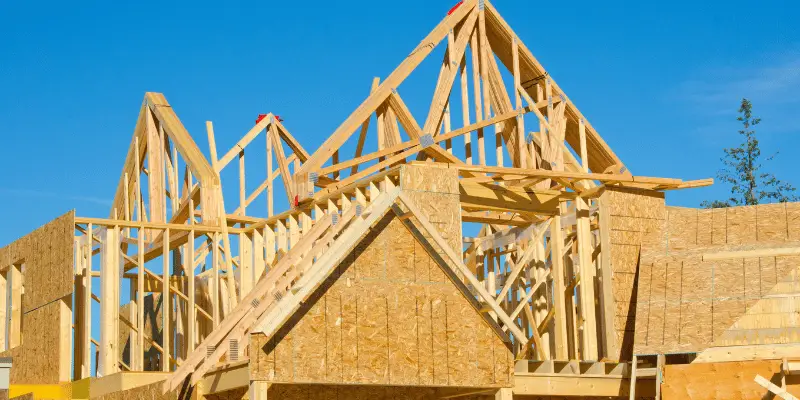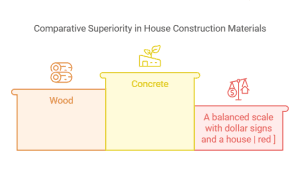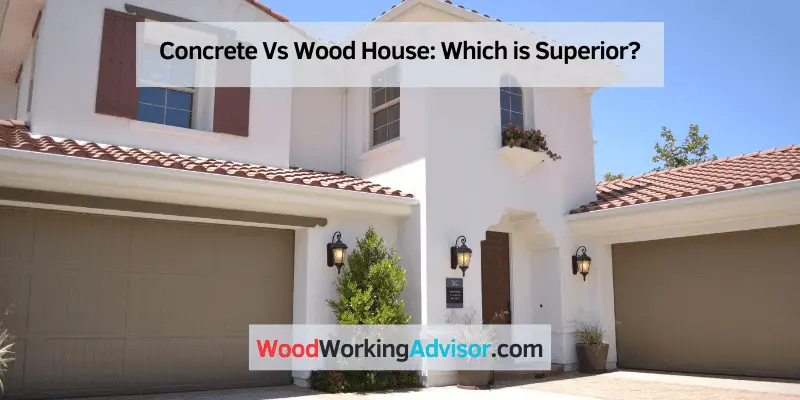Concrete houses are durable and low-maintenance, while wood houses offer versatility and a natural aesthetic.
Concrete Vs Wood House: Comparing Sustainability
When it comes to choosing the right material for your home, the sustainability factor plays a crucial role. Concrete and wood are two popular choices, each with its own unique set of benefits and considerations. In this article, we will explore the sustainability aspects of both concrete and wood houses, shedding light on their environmental impact, use of renewable resources, longevity, durability, and carbon footprint.
Environmental Impact Of Concrete Construction
Concrete construction has known environmental impacts due to its production process. The manufacturing of concrete involves the extraction and processing of raw materials, such as limestone, clay, and sand. This process contributes to the release of carbon dioxide, a greenhouse gas that contributes to climate change. Moreover, the energy-intensive nature of concrete production contributes to high levels of carbon emissions.
Wood As A Renewable Resource
Wood, on the other hand, is a natural and renewable resource. It comes from trees that absorb carbon dioxide throughout their growth, helping mitigate climate change. Trees can be sustainably harvested, meaning that for every tree cut down, multiple new trees can be planted to maintain the supply. This makes wood a more sustainable choice in terms of resource management.
Longevity And Durability Considerations
When it comes to longevity and durability, both concrete and wood houses have their own advantages. Concrete is known for its durability and resistance to fire, pests, and natural disasters. A properly constructed concrete house can last for many decades with minimal maintenance. On the other hand, wood houses can also have a long lifespan if proper maintenance and care are provided. Regular inspections, treatments, and protection against pests and moisture are essential to ensure the longevity and durability of a wood house.
Carbon Footprint Comparison
The carbon footprint of a house encompasses the total amount of greenhouse gas emissions, including those generated during the construction phase and throughout the life of the house. While concrete production has higher initial carbon emissions, it is important to consider the entire lifecycle of the building materials. Wood houses have a lower carbon footprint associated with their production. However, the carbon stored within wood can be released back into the atmosphere if proper maintenance is not carried out, such as protecting it from moisture and decay.
| Material | Initial Carbon Emissions | Lifecycle Carbon Emissions |
|---|---|---|
| Concrete | High | Medium |
| Wood | Low | Low (with proper maintenance) |
The above table summarizes the initial and lifecycle carbon emissions for concrete and wood houses. It is important to note that the carbon footprint of a house can also be influenced by other factors, such as energy-efficient design, insulation, and energy sources used for heating and cooling.
Considering the sustainability aspects, both concrete and wood houses have their own strengths and weaknesses. It’s essential to evaluate factors like environmental impact, resource renewability, longevity, and carbon emissions to make an informed decision when choosing the material for your house.

Cost Implications In Construction
Initial Material And Labor Costs For Concrete
When it comes to building a house, the initial costs of both materials and labor play a crucial role in decision-making. Concrete, with its durable and long-lasting properties, has been a popular choice for construction projects. The initial material costs for concrete houses can vary depending on the type and quality of the concrete used.
Typically, the cost of concrete ranges from $75 to $150 per square foot, including the labor costs for pouring and finishing. Additionally, the construction time for concrete houses tends to be longer than wood houses, which can also influence labor costs. However, it’s important to note that these costs are subject to geographical location, project complexity, and market factors, which can influence the overall expenses.
Wood Building Expenses Analysis
Wood, on the other hand, has long been favored for its affordability and versatility in construction. The initial material costs for wood houses are generally lower than concrete houses, ranging from $50 to $100 per square foot.
This cost advantage is partly due to the accessibility and abundance of wood as a natural resource. Additionally, the construction time for wood houses is typically quicker than concrete houses, resulting in lower labor costs. However, it’s important to consider that wood houses may require additional measures for fire-proofing and pest control, which can add to the overall expenses.
Long-term Financial Benefits And Drawbacks
Looking beyond the upfront costs, evaluating the long-term financial benefits and drawbacks is essential. Concrete houses are known for their durability, withstanding natural disasters such as hurricanes and earthquakes better than wood houses. This durability can lead to lower maintenance and repair costs over the years, increasing their long-term financial benefits.
On the flip side, concrete houses can be more expensive to remodel or modify due to their structural nature, limiting their flexibility in adapting to changing needs. Wood houses, while generally requiring more maintenance, offer greater flexibility for modifications or expansions at a lower cost. However, they can be more susceptible to damage from natural elements and pests, potentially resulting in higher long-term maintenance and repair expenses.
Maintenance And Repair Considerations
In addition to the long-term financial impact, maintenance and repair considerations should also be factored in. Concrete houses typically require less frequent maintenance as they are resistant to rot, decay, and termite damage. However, periodic inspections and maintenance of the foundation, such as sealing cracks or fixing settlement issues, are necessary to ensure their structural integrity.
On the other hand, wood houses require regular maintenance, including painting, staining, and treating against pests and decay. While this adds to the ongoing expenses, regular maintenance can extend the lifespan of the wood, preserving its aesthetic appeal and structural integrity.
In conclusion, both concrete and wood houses have their unique cost implications in construction. The initial material and labor costs for concrete may be higher, but its durability and potential lower long-term maintenance costs can offset these expenses. Wood houses offer affordability upfront and flexibility for modifications, but regular maintenance and potential repair costs need to be considered. Ultimately, the decision between concrete and wood comes down to individual preferences, geographical factors, and project requirements.
Safety Aspects In Material Selection
When it comes to constructing a house, one of the most crucial decisions to make is the choice of materials. The materials used for construction not only determine the aesthetic appeal and durability of the house but also play a significant role in ensuring the safety of its occupants. In this section, we will explore the safety aspects of two commonly used building materials: concrete and wood.
Fire Resistance In Concrete And Wood Structures
Fire safety is a paramount concern for homeowners. Both concrete and wood have different properties when exposed to fire, making it essential to consider this aspect during material selection.
Concrete structures, owing to their density and composition, possess remarkable fire resistance. Concrete does not burn, and its slow heat conductivity helps to restrict the spread of fire. This is particularly important in areas prone to wildfires or accidents involving fire hazards.
On the other hand, wood structures are more susceptible to fire hazards. While wood can ignite easily, its compact structure allows the flames to spread rapidly, posing a significant risk to the occupants and neighboring properties.
Weather And Natural Disaster Considerations
Another important aspect to consider when selecting materials is their ability to withstand extreme weather conditions and natural disasters.
Concrete structures offer exceptional durability and can resist the effects of harsh weather conditions such as heavy rain, strong winds, and extreme temperatures. Their solid composition ensures structural stability, reducing the risk of damage or collapse during hurricanes, earthquakes, or other natural disasters.
Wood, on the other hand, is more vulnerable to weather elements and natural disasters. Without proper maintenance, wood can deteriorate over time due to moisture, rot, or termite infestation. Additionally, wood structures may not hold up well during strong winds or earthquakes, which can compromise the safety of the occupants.
Pest Resistance And Structural Integrity
When it comes to long-term safety, the resistance to pests and structural integrity of the chosen material are crucial considerations.
Concrete structures are highly resistant to pests such as termites and other wood-damaging insects. This makes them an excellent choice for homeowners concerned about the structural integrity of their property.
Wooden structures, however, are susceptible to pest infestations if not properly treated and maintained. Termites, in particular, can cause significant damage to the wood, compromising the stability and safety of the building.
Summary
In summary, concrete structures offer superior fire resistance, weather resilience, and pest resistance, making them a safer choice for homeowners. While wood may have its own aesthetic appeal, it is essential to carefully consider the safety aspects before making a final decision. The choice of material ultimately determines the long-term safety and well-being of the occupants, making it a decision that should not be taken lightly.
Aesthetic And Functional Qualities
When it comes to choosing the material for your house, considering both aesthetic and functional qualities is essential. Concrete and wood are two popular options known for their unique characteristics. Let’s explore the architectural flexibility, comfort and insulation differences, and interior and exterior design potentials of these materials.
Architectural Flexibility Of Wood And Concrete
The architectural flexibility of Wood and Concrete plays a vital role in determining the overall design and structure of a house.
- Wood: With its natural beauty and warm, earthy tones, wood offers a high level of flexibility in architectural design. Its malleability allows for intricate detailing and complex shapes, making it a favored choice for unique and visually appealing structures. Whether you prefer a traditional log cabin or a modern timber-frame house, wood effortlessly adapts to various architectural styles.
- Concrete: Although typically associated with an industrial aesthetic, concrete has evolved to be an expressive medium in contemporary architecture. Its versatility enables architects to explore innovative forms and sophisticated designs. From the sleek lines of a minimalist dwelling to the sculptural elements of brutalism, concrete provides a strong foundation for exploring diverse architectural concepts.
Comfort And Insulation Differences
When it comes to comfort and insulation, both wood and concrete have distinct qualities that impact the overall livability of a house.
- Wood: Known for its natural insulating properties, wood effectively regulates temperature and provides sound insulation. This material offers excellent thermal performance, keeping indoor spaces warm in winter and cool in summer. Its inherent ability to absorb and release moisture also creates a comfortable and healthy living environment.
- Concrete: Concrete is known for its ability to retain and radiate heat, making it ideal for regions with colder climates. However, its thermal mass properties can also lead to increased energy consumption during warmer months, requiring additional cooling measures. While concrete may lack the natural insulation of wood, advancements in construction techniques and insulation materials have significantly improved its thermal efficiency, reducing potential energy loss.
Interior And Exterior Design Potentials
The choice between wood and concrete can greatly influence the design potentials of both the interior and exterior of a house.
- Wood: With its warm and welcoming appearance, wood effortlessly adds a sense of coziness and natural beauty to any interior space. From exposed timber beams to hardwood floors, incorporating wood elements brings a timeless and inviting charm to the overall design. Externally, wood siding or cladding options offer a range of aesthetics, from rustic cedar to modern composite panels, allowing for diverse architectural expressions.
- Concrete: Concrete provides a sleek and contemporary look to interior spaces. Polished concrete floors, exposed structural details, and smooth countertops contribute to a modern and industrial vibe. Externally, concrete finishes can range from raw and textured to refined and smooth, offering countless design possibilities. Additionally, concrete’s durability allows for unique sculptural features and the integration of materials like glass and steel.
Choosing between concrete and wood for your house ultimately depends on your personal preferences, the architectural style you desire, and the climatic conditions of your location. Consider the aesthetic and functional qualities of each material to make an informed decision that suits your unique vision and lifestyle.
Assessing Resale Value And Market Trends
When it comes to buying or selling a property, resale value is one of the most significant factors to consider. The choice of construction material can greatly influence how much a house is worth in the market. In this section, we will explore how concrete and wood houses differ in terms of their impact on property value, current consumer preferences in housing, and predicting future market shifts.

Influence Of Construction Materials On Property Value
The construction material of a house carries substantial weight in determining its resale value. Concrete and wood are two common options, each with its unique characteristics. A concrete house offers durability, strength, and longevity, which are highly desirable qualities for potential buyers. On the other hand, wood houses exude warmth, charm, and a more traditional aesthetic appeal. While concrete houses tend to have higher initial costs, they often boast a higher resale value due to their long-lasting nature.
Current Consumer Preferences In Housing
The preferences of consumers play a pivotal role in determining market trends. Currently, there is a growing demand for eco-friendly and sustainable housing options. Many buyers seek environmentally responsible homes, making wood houses an attractive choice due to their renewable and biodegradable nature. Wood houses are often considered more energy-efficient as they generally require less heating or cooling compared to concrete houses. Additionally, wood houses can be easily customized and modified, allowing buyers to personalize their living spaces according to their preferences.
Predicting Future Market Shifts: Concrete Vs Wood House
Anticipating future market shifts is crucial for both buyers and sellers. Although concrete houses dominate the market currently, there is a gradual shift towards sustainable building practices and renewable materials. As environmental consciousness continues to grow, the demand for wood houses may increase.
Furthermore, technological advancements in wood treatment and construction techniques may enhance the durability and performance of wood houses, making them a strong contender in the future market. Therefore, it is important to consider the potential long-term value and trends associated with building a concrete or wood house.
Frequently Asked Questions Of Concrete Vs Wood House
Is A Concrete House Better Than Wood?
Concrete houses are stronger and more durable than wood. They provide better protection against natural disasters and are resistant to pests. Additionally, concrete houses require less maintenance and have better insulation. Ultimately, concrete houses are a superior choice in terms of longevity and safety.
What Is The Disadvantage Of Concrete House?
The disadvantage of a concrete house is that it can be costly to build and repair due to the specialized labor and materials required. Additionally, concrete houses may have limited design options and can be prone to cracking or other structural issues over time.
What Is The Life Expectancy Of A Concrete House?
A concrete house typically has a life expectancy of 50 to 100 years, depending on factors such as maintenance, location, and weather conditions. Regular upkeep can extend the lifespan.
What Is The Lifespan Of Wood Vs Concrete?
The lifespan of wood is typically around 20 to 30 years, while concrete can last for several decades or more. Concrete is known for its durability and resistance to weathering, making it a longer-lasting option compared to wood. However, the actual lifespan depends on factors like maintenance and quality of materials used.
Conclusion
Both concrete and wood houses have their advantages and drawbacks. Concrete houses offer durability and solid construction, while wood houses provide a natural and aesthetically pleasing option. Factors such as cost, location, and personal preferences contribute to the decision between the two.
Ultimately, the choice depends on the specific needs and priorities of the homeowner. Consider all these factors before making a decision for your dream home.

